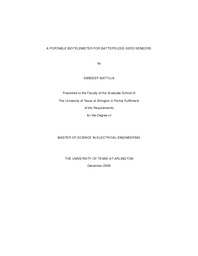
ATTENTION: The works hosted here are being migrated to a new repository that will consolidate resources, improve discoverability, and better show UTA's research impact on the global community. We will update authors as the migration progresses. Please see MavMatrix for more information.
Show simple item record
| dc.contributor.author | Battula, Sandeep | en_US |
| dc.date.accessioned | 2010-03-03T23:30:36Z | |
| dc.date.available | 2010-03-03T23:30:36Z | |
| dc.date.issued | 2010-03-03T23:30:36Z | |
| dc.date.submitted | January 2009 | en_US |
| dc.identifier.other | DISS-10467 | en_US |
| dc.identifier.uri | http://hdl.handle.net/10106/2039 | |
| dc.description.abstract | In many medical problems, a continuous monitoring of the disease in vivo is essential to prevent further deterioration of health. The monitoring usually exceeds 24 hours. With the help of current advanced technologies, micro-medical devices are built to sense the internal physiological conditions in patients. Telemetry is used to transmit information to an external monitoring device. For the convenience and comfort of the patient, these monitoring systems should have low power consumption and be portable. This work discusses the design of a low power portable biotelemeter for batteryless Gastro esophageal reflux disease (GERD) sensors which can detect acid and non-acid refluxes in esophagus. When a batteryless GERD sensor is placed in the working region of the telemeter, it should wirelessly power up the sensor and receive a modulated physiological signal from the implant. The sensor signals should be extracted from this modulated signal using a demodulation circuit. In the GERD monitoring, depending on the modulated frequency changes, the acid refluxes in esophagus then can be detected. A microcontroller was introduced to measure, process and record this information signals. To record this data to a secured digital (SD) card, the Serial Peripheral Interface (SPI) mode communication link was setup between the card and microcontroller. In the SD card, the measured signal is recorded with its corresponding time stamp in a TEXT file format. Using the microcontroller, the total power consumption was reduced by controlling the timings of powering up the batteryless sensor. Experiments were conducted to study the effect of different environmental parameters including distances, motion artifacts, and misalignment on the measured signals. Performance and stability of the system were also studied in the experiments. The designed biotelemeter has a reading range up to 6 cm along z-axis, with less than 5% change in the measured frequency. All the frequencies measured at every point within the reading range are repeatable. When sensor is not perfectly aligned to telemeter at a distance of 1.5cm, the maximum allowable tilt is ± 60 deg about the x-axis, ±55deg about the y-axis and no change about the z-axis. The shift in the frequency because of the refluxes is much higher than the change in the frequency with any environmental parameter, so the signal to noise ratio is maintained. The frequency measured is stable with the battery voltage, time and any other parameter. The power consumption of the device is improved with a closed loop timing control using the microcontroller by 34 times. | en_US |
| dc.description.sponsorship | Chiao, Jung-Chih | en_US |
| dc.language.iso | EN | en_US |
| dc.publisher | Electrical Engineering | en_US |
| dc.title | A Portable Biotelemeter For Batteryless GERD Sensors | en_US |
| dc.type | M.S. | en_US |
| dc.contributor.committeeChair | Chiao, Jung-Chih | en_US |
| dc.degree.department | Electrical Engineering | en_US |
| dc.degree.discipline | Electrical Engineering | en_US |
| dc.degree.grantor | University of Texas at Arlington | en_US |
| dc.degree.level | masters | en_US |
| dc.degree.name | M.S. | en_US |
| dc.identifier.externalLink | https://www.uta.edu/ra/real/editprofile.php?onlyview=1&pid=232 | |
| dc.identifier.externalLinkDescription | Link to Research Profiles | |
Files in this item
- Name:
- Battula_uta_2502M_10467.pdf
- Size:
- 2.687Mb
- Format:
- PDF
This item appears in the following Collection(s)
Show simple item record


